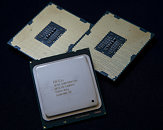Tuesday, March 24th 2015

Intel to Launch Just Two LGA1150 "Broadwell" Parts
In what could be a sign of Intel being stuck with "undigested" Core "Haswell" inventories, BGA chips becoming commonplace for desktop platforms that don't see CPU upgrades, or even "Broadwell" being too short a stopgap between "Haswell" and "Skylake," the company has reportedly decided to launch just two socket LGA1150 Core "Broadwell" parts, when the silicon hits the market towards June.
Built in the 14 nm silicon fab process, "Broadwell" will bring about performance/Watt increments, and Intel doesn't appear to be in the mood to trade those in for higher clock speeds (higher performance out of the box). It's relevant to note here, that the "Broadwell" core is essentially an optical shrink of the "Haswell" CPU architecture to 14 nm, much like "Ivy Bridge" was to "Sandy Bridge," even if the silicon seating the cores itself is much different (meatier iGPU). Intel will be going in with just two parts, both of which are unlocked, for PC enthusiasts to chew on. These include the Core i7-5775C and the Core i5-5675C.Both the i7-5775C and the i5-5675C are quad-core parts, with TDP rated as low as 65W. The i7-5775C offers clock speeds of 3.30 GHz, with 3.70 GHz Turbo Boost, while the i5-5675C offers 3.10 GHz, with 3.60 GHz Turbo Boost. The i7-5775C comes with just 6 MB of L3 cache, while the i5-5675C offers just 4 MB of it. The i7-5775C offers HyperThreading, letting the OS address eight logical CPUs, while the i5-5675C lacks it. Both chips feature Intel's Iris Pro 6200 series integrated graphics, and feature dual-channel DDR3L-1600 memory support. It will be interesting to see how the two compare to the existing i7-4790K and i5-4690K, although something tells us that they're not comparable. The two will be compatible with existing LGA1150 motherboards, with BIOS updates.
Source:
VR-Zone
Built in the 14 nm silicon fab process, "Broadwell" will bring about performance/Watt increments, and Intel doesn't appear to be in the mood to trade those in for higher clock speeds (higher performance out of the box). It's relevant to note here, that the "Broadwell" core is essentially an optical shrink of the "Haswell" CPU architecture to 14 nm, much like "Ivy Bridge" was to "Sandy Bridge," even if the silicon seating the cores itself is much different (meatier iGPU). Intel will be going in with just two parts, both of which are unlocked, for PC enthusiasts to chew on. These include the Core i7-5775C and the Core i5-5675C.Both the i7-5775C and the i5-5675C are quad-core parts, with TDP rated as low as 65W. The i7-5775C offers clock speeds of 3.30 GHz, with 3.70 GHz Turbo Boost, while the i5-5675C offers 3.10 GHz, with 3.60 GHz Turbo Boost. The i7-5775C comes with just 6 MB of L3 cache, while the i5-5675C offers just 4 MB of it. The i7-5775C offers HyperThreading, letting the OS address eight logical CPUs, while the i5-5675C lacks it. Both chips feature Intel's Iris Pro 6200 series integrated graphics, and feature dual-channel DDR3L-1600 memory support. It will be interesting to see how the two compare to the existing i7-4790K and i5-4690K, although something tells us that they're not comparable. The two will be compatible with existing LGA1150 motherboards, with BIOS updates.

53 Comments on Intel to Launch Just Two LGA1150 "Broadwell" Parts
It's in the roadmaps. Why do people think it'll be upgrade worthy?
Looks like sandy/ivy systems will live until they actually die.
I haven't seen any leaks yet
i think my Ivy its gona last 3 years more,
About broadwell, IHS will be soldered, not glued like the crap work they did with Ivy's and Haswell?
Regards,
Would love to see these and I am glad they are at least releasing something. I think the new naming convention is interesting as well.
I'm sure Skylake will be properly exciting and bring about some real performance and feature improvements making it worth my time to upgrade from my trusty 2700K which has served me really well for over 3 years now.
Would be nice to see an overclock to 6GHz+ from it on air...
Is not worth enough to replace your current Sandy or Ivy Bridge unit for a broadwell one, mostly on gaming an OCed i5 2500K can handle all what you will do with a new processor, we recommend people o buy haswell for new builds because availability and also opportunity, prices between brand new sandies, ivys and haswell are not so big, so for a couple of dollars more getting recent units is a solid unit.
Also for work and light work the old intel Core 2 Quad are brave units, I have a previous gen Intel i7 for work and hard work, also it is crunching too, so we can add Lynnfield to our veterans list,
Lynnfield, Sandy Bridge and Ivy Bridge are brave enough for a couple of years more of gaming, working and whatever you want,
The whole point of LGA Broadwell chips was to give an upgrade path to people already invested in Haswell. Anyone sitting on Haswell K has no reason to consider Broadwell. That makes me think these chips will be going after people who brought the anniversary Pentium chip. They've got value oriented overclocking boards designed for the 53 watt monster, so a 65 watt upgrade should be a drop in replacement. And since that chip and the motherboards they're in are on the lower end of the price spectrum, these chips should continue that trend. They should be the lowest priced unlocked I5 and I7 chips Intel has put out, and be very price competitive with the low end of the Haswell I5 and I7 spectrum ($200 and $300 respectively)
the GTX670 on the other hand? Yep, once the Freesync/G-Sync 1440 monitors drop below $500, that will get replaced.